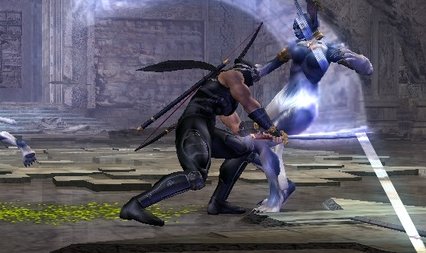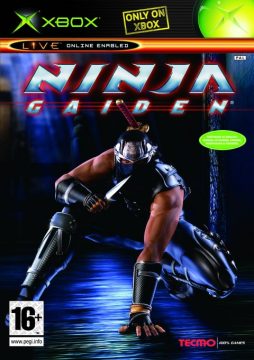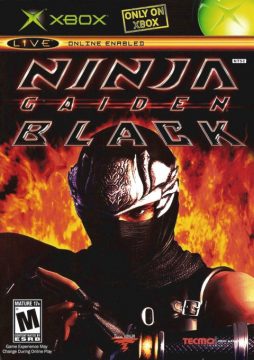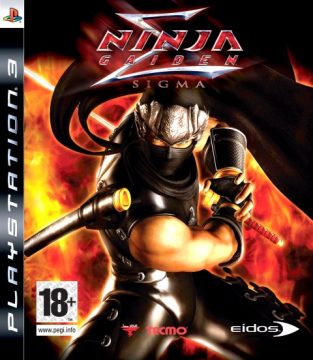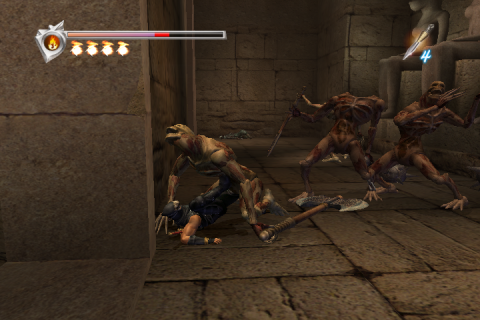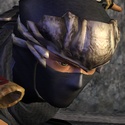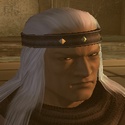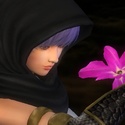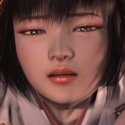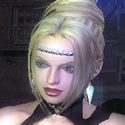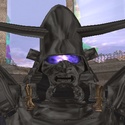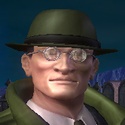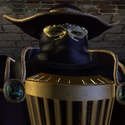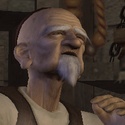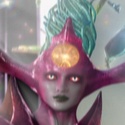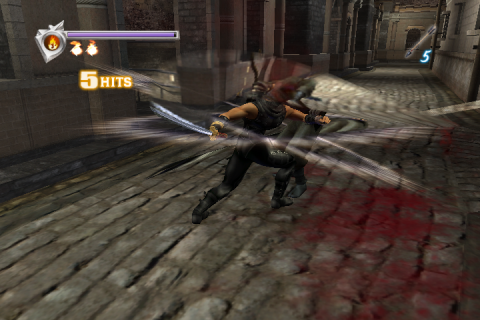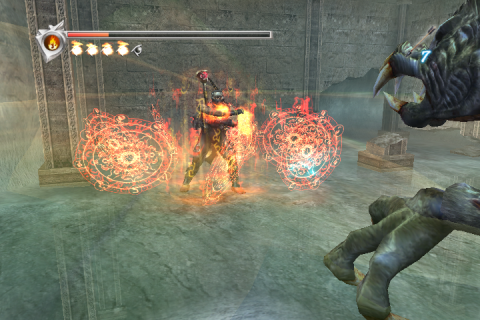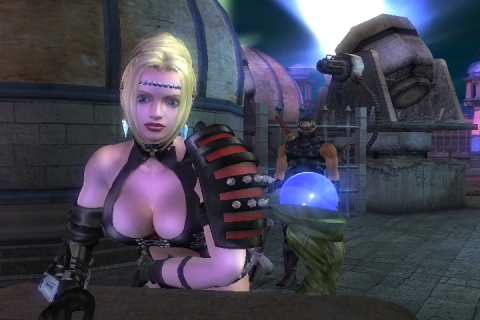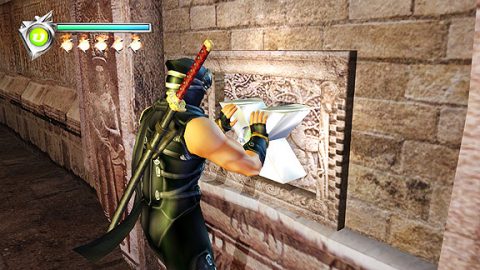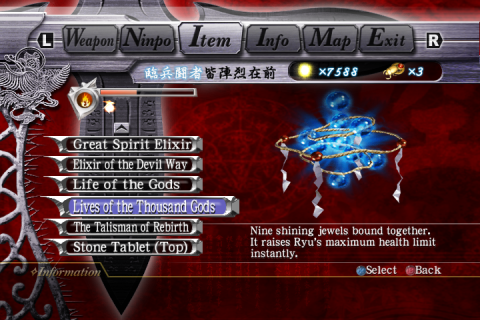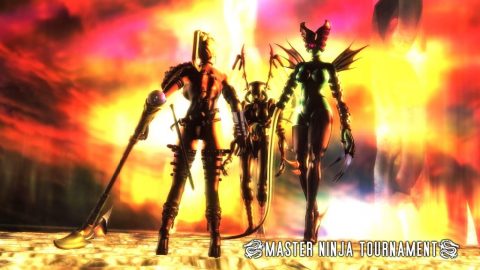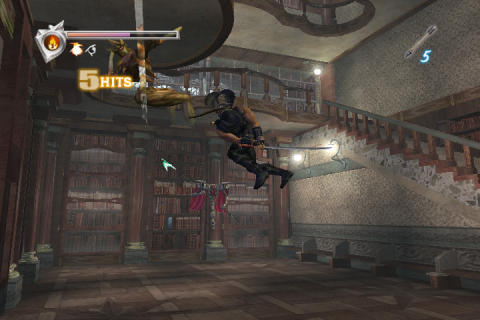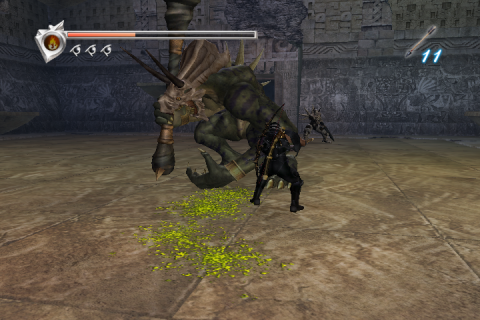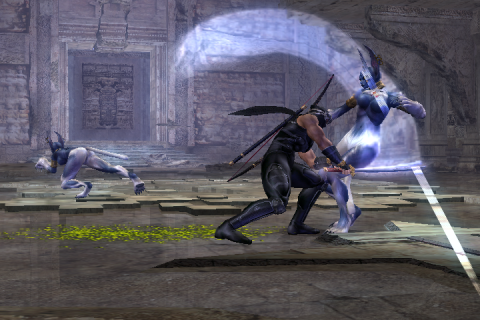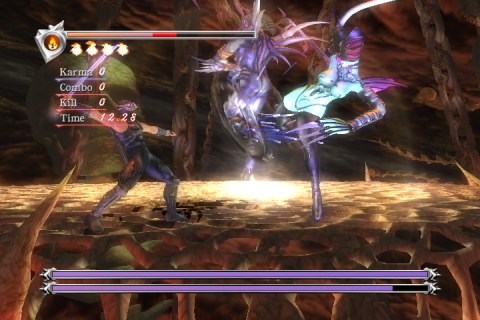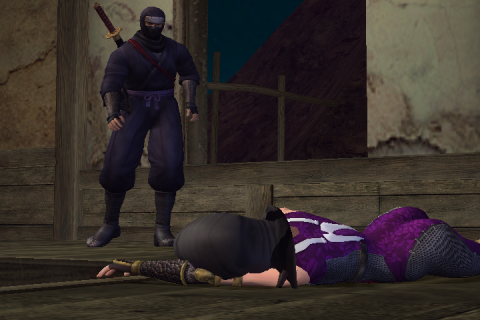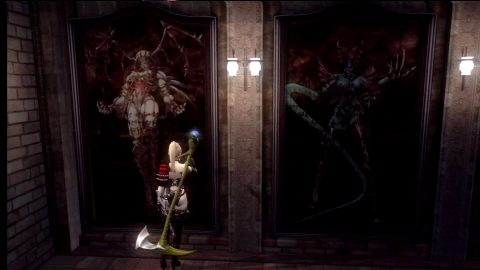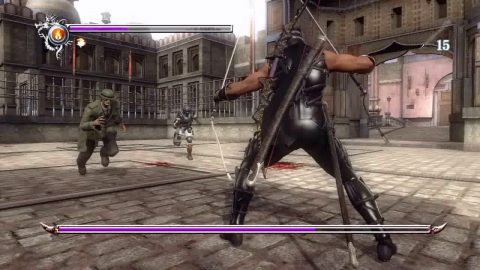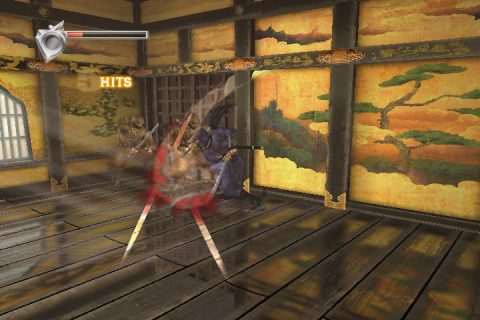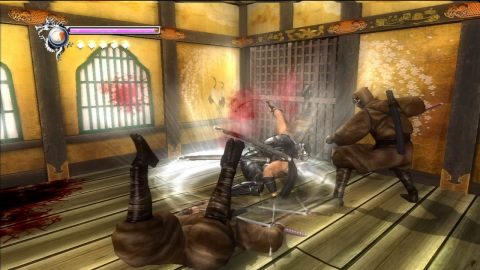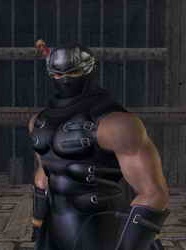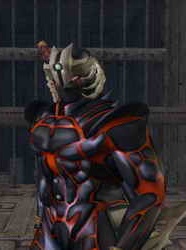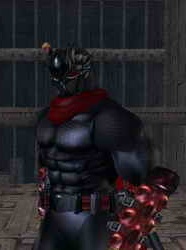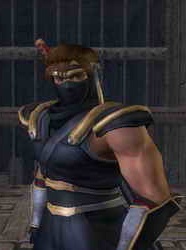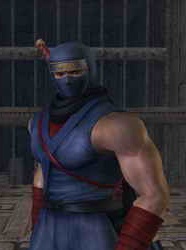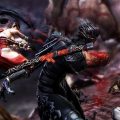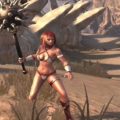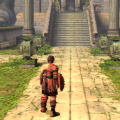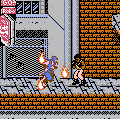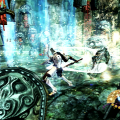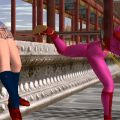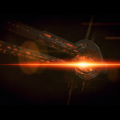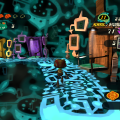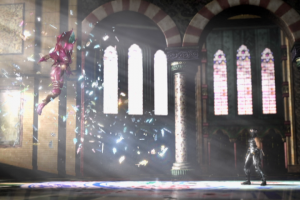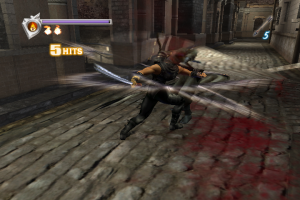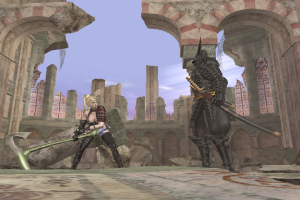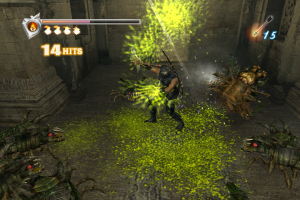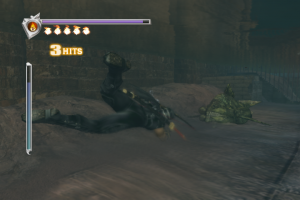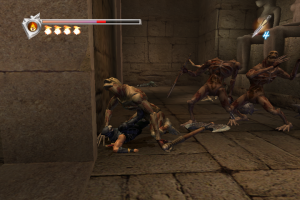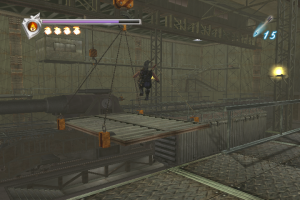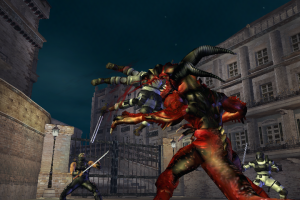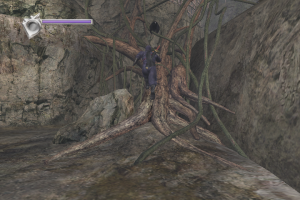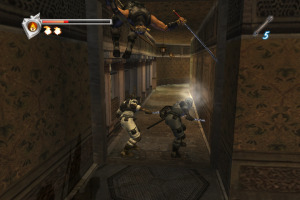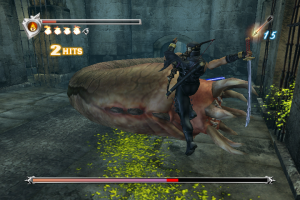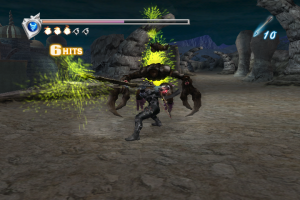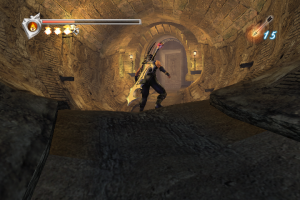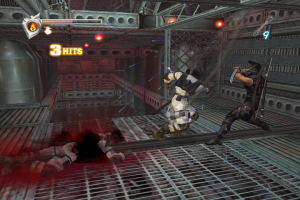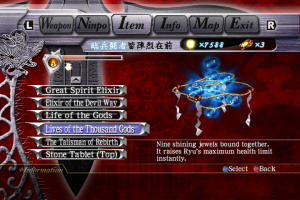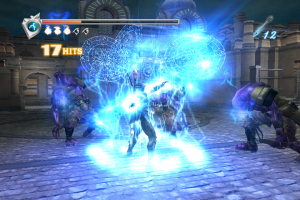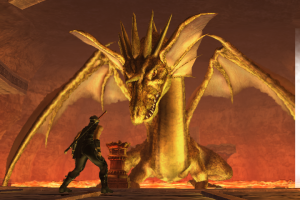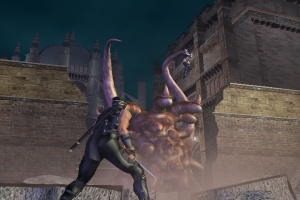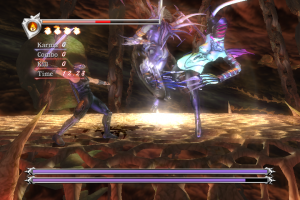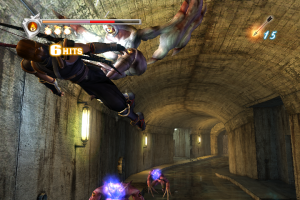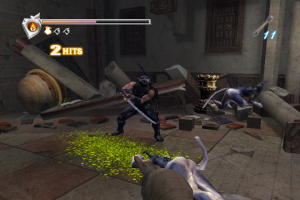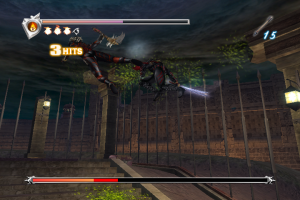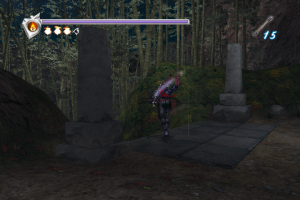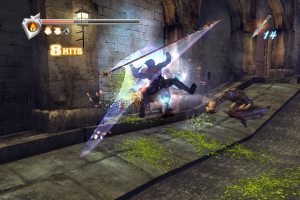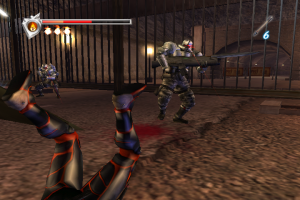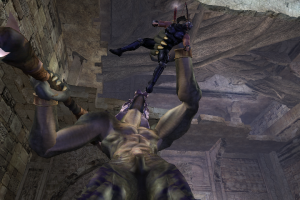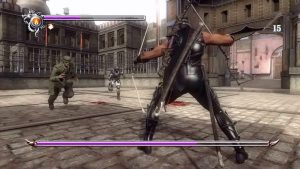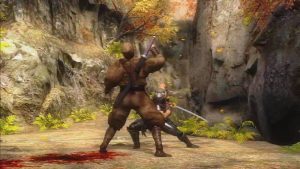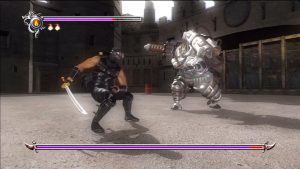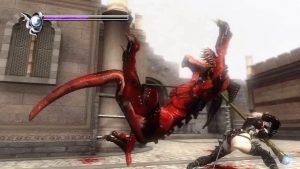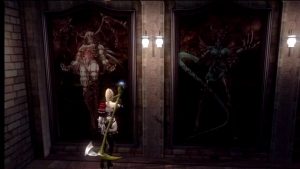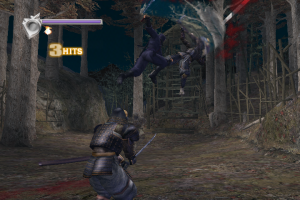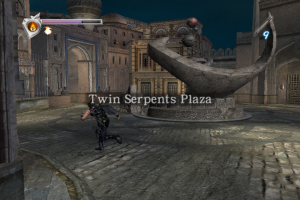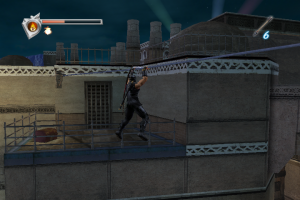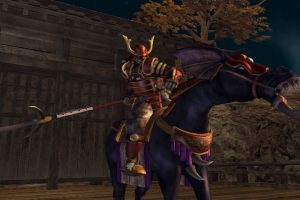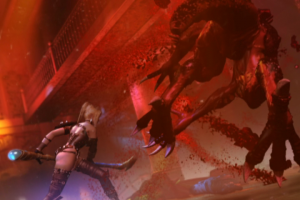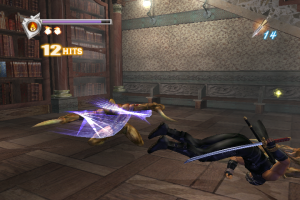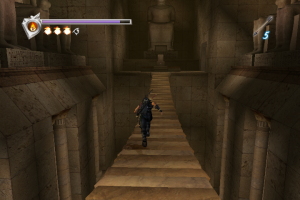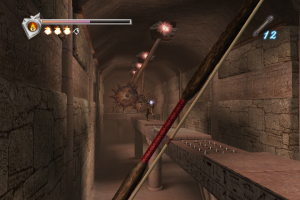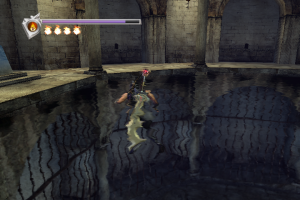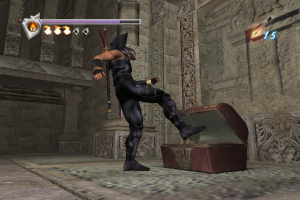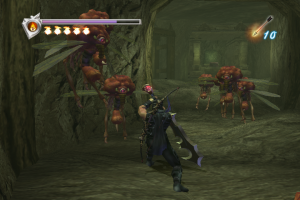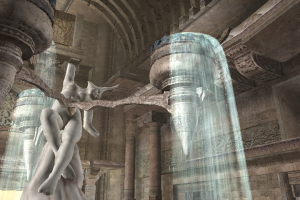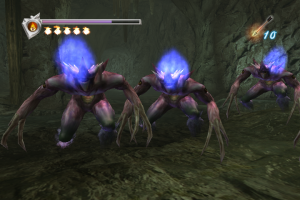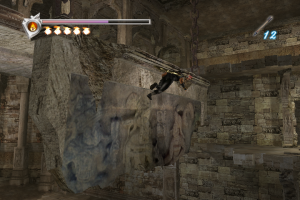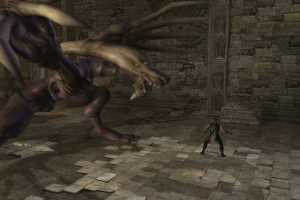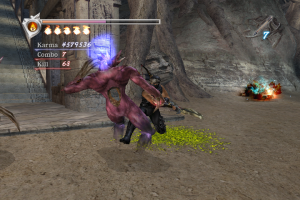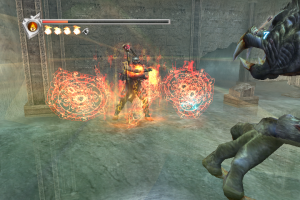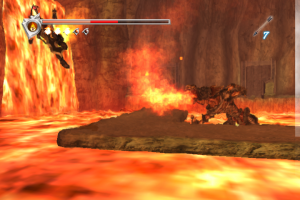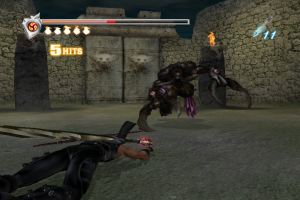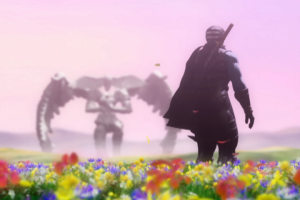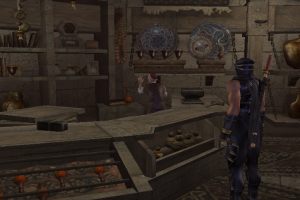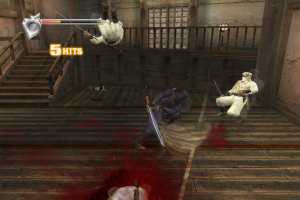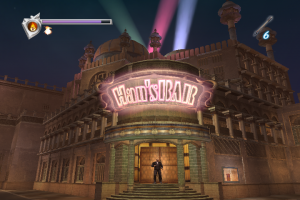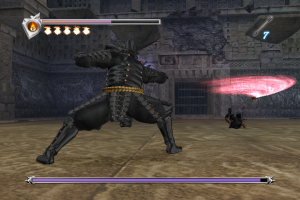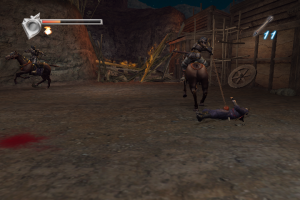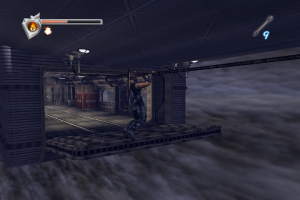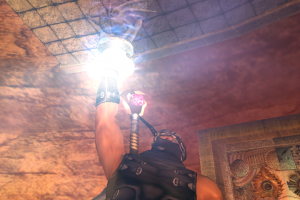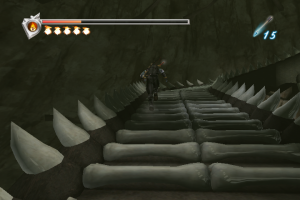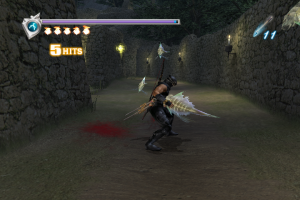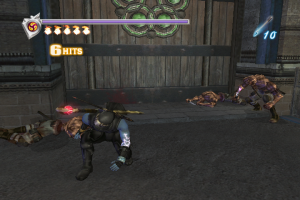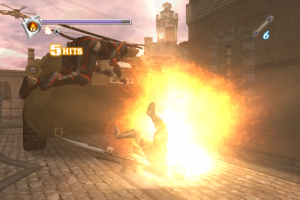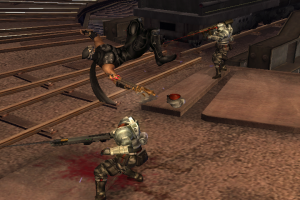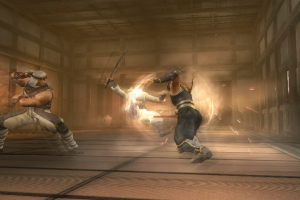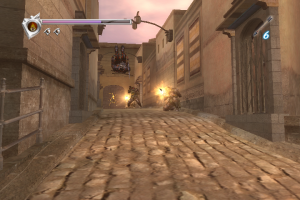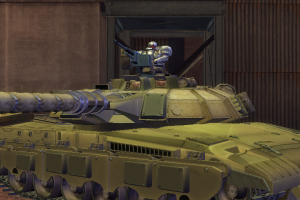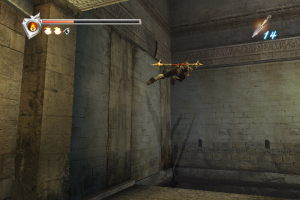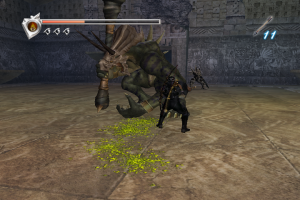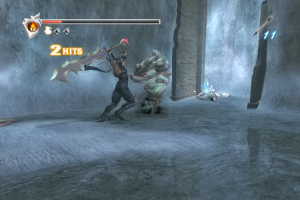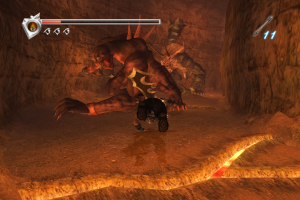- Ninja Gaiden (Arcade)
- Ninja Gaiden (NES)
- Ninja Gaiden II (NES)
- Ninja Gaiden III (NES)
- Ninja Gaiden Shadow
- Ninja Gaiden (Game Gear)
- Ninja Gaiden (Master System)
- Ninja Gaiden (Genesis)
- Ninja Gaiden (2004)
- Ninja Gaiden: Dragon Sword
- Ninja Gaiden II (2008)
- Ninja Gaiden 3 (2012)
- Yaiba: Ninja Gaiden Z
- Ninja Gaiden Old & New
- Ninja Gaiden: Miscellanous
- Masato Kato (Interview)
After more than ten years of creative idleness on the franchise, Tecmo finally announced to revive Ninja Gaiden at E3 2002. It seems only logical that Team Ninja, of Dead or Alive fame, would take over the development, for the obvious reason. From the first trailer, the new Ninja Gaiden showed off greatly staged fighting action with awesome cut scenes (a few of which for some reason never made it into the final game), looking like the definite future of action games.
The storyline doesn’t follow anything from the NES games, but rather reinvents the whole universe to start anew, as is common with the revival of classical game franchises nowadays. Ryu is sent to a friendly Ninja fortress for training, while his father is out somewhere in the mountains to perfect his skills. With the clan’s two most skilled warriors away, the Hayabusa ninja village is attacked, and most of its inhabitants slaughtered. The Dark Dragon Blade, an evil sword they’ve protected for centuries, gets stolen by the evil fiend Doku (yes, this time it’s not ‘demon’, although the Japanese original provides no particular reason to translate it this way). To seek revenge, and to retrieve the dangerous blade, Ryu follows Doku into the fictional empire of Vigoor, killing pretty much everything that stands in his way.
Once again not a very exciting story, but like the old Trilogy, it is presented in an exciting way, though of course not as groundbreaking at the cutscenes were in 1989. Some of the characters are at least promising, but they don’t get nearly enough screen time to get fleshed out or made interesting. Particularly in the second half of the game, you’re mostly just fighting through the world and story-related cut scenes are rare and usually rather short. It’s not a bad story by any means, but it stays very shallow most of the time and Team Ninja doesn’t really bother to ever tie up all the loose ends.
The Cast
Ryu Hayabusa
No Ninja Gaiden without everyone’s favorite modern super ninja. His father, Joe Hayabusa, left their village to train in the mountains. Holding the Dragon Sword in his father’s absence, he visits Murai’s ninja hideout to receive further training.
The mysterious kunoichi imported from the Dead or Alive series. She helps Ryu with information and other supporting action along the way. If you play badly in Ninja Gaiden Black, she offers to make Ryu her ninja dog in exchange for help.
A woman from Ryu’s village, she is protecting the Dark Dragon Blade. During the game, she doesn’t do much more than to die in a cut scene, but for some reason she was important enough to the developers to put her in the manual nonetheless…
After starting the game, climbing up the ninja fortress and fighting your first few enemies, you’ll notice that the controls are tight and very responsive, giving you perfect control over Ryu most of the time. From the beginning, you have an adequate set of moves and combos at your disposal, which grows bigger and bigger through the game as you get new weapons and upgrade old ones. There’s a total of about eight hand-to-hand weapons, though a lot of them are rendered obsolete as soon as you receive the next better weapon from the same class. So you have Nunchucks, which are followed by the bladed Vigorian Flail, as well as the War Hammer, which is useless after you get the Dabilahro, a giant two-handed sword. Ryu’s Dragon Sword literally gets replaced by the True Dragon Sword or another, secret weapon. The only weapons that stand out on their own are the Unlaboured Flawlessness, which deals more damage the less health Ryu has left, and the Kotetsu, some kind of ghost Katana that turns into double wielded swords for some moves and draws from Ryu’s health unless he keeps constantly killing things, like in the PlayStation 2 Shinobi game.
Then there’s ranged weapons like shurikens, a bow with several kinds of arrows, and explosive kunais. A spear gun for some reason is classified as a melee weapon, but it really is a gun to catch (read: kill) fish under water. There are a few situations and enemies where you have to use the bow, but all the other ranged weapons are secondary. You also have to make good use of Ryu’s acrobatic abilities to run and jump up walls or run on water, the latter one being one of the coolest moves in an action game ever. A lot of these techniques can also be incorporated into combat. The last card Ryu’s got up his sleeve are the “Ninpo”, the ninja equivalent to magic. An arsenal of four spells in total can be gathered throughout the adventure. They are of limited use, though, due to the long time it takes to prepare them, and they’re almost pointless to use against bosses. The only really effective way to use them is to protect yourself for a while in their invincibility aura and get rid of surrounding enemies, making some room around Ryu.
Destroyed enemies leave colored essence, with blue and red essence filling up health and Ninpo magic, respectively. Yellow ones are the currency used to buy stuff from Muramasa, like weapons, healing items or bracelets. The latter bring various strengthening effects like raised attack power or a slowly refilling life bar. Alternately, instead of collecting the essence, you can absorb it for a mighty ultimate attack. Enemies killed by that attack leave even more valuable yellow essence, in addition to greatly improving your karma (read as: score).
Other than most action games, you won’t mow down enemies by the hundreds just through your physical superiority. Every single group of enemies will provide a challenge, and you’re bound to end up dead if you don’t learn to block and evade attacks properly. For instance, at about mid-game, you come across soldiers that attack with machine guns. Sure, you can block their attacks, but then they run up, grab you, and slit your throat. On the harder difficult levels, a lot of them will actually take more hits than Ryu can, even just ordinary mooks. This makes combat highly intensive and Ninja Gaiden is definitely the most refined game of its genre in that department. It’s no walk in the park, that’s for sure, and the unusually high difficulty (for modern standards) was one of the major reasons leading to some mixed reviews at the time. However, if you’re willing to learn the way it is played and make good use of blocks and evades, it’s not as hard as most sources make it out to be.
There are a few quirks that spoil the experience to some degree, though. First, you don’t have any direct choice which enemy you’re going to attack. Ryu will always slash toward the nearest one, which can get really annoying in unfortunate instances, and even, in the worst case, get him killed. There’s also no distinction whether you attack someone or interact otherwise with your environment, so sometimes you’ll leave a room when you want to attack an enemy near a door, and the next time you’ll keep on attacking when all you want is to flee through that same door. The second and most criticized problem of the entire game is the camera. It often has a hard time focusing on the action, and in the original release the only way to adjust is by pressing the right trigger, which will place the camera behind Ryu, similar to the 3D Zelda games. What worked with Zelda, a series which is mainly focused on exploration and puzzle solving, isn’t quite sufficient for this type of fast and furious action game, so you better learn how to fight without seeing what you’re doing. Although that is totally possible, it still will drive you insane when trying to get a straight angle for a jump in certain platforming passages, since a lot of them are constructed in a way that you’re just barely able to see anything.
Besides all the fighting and sporadical platforming, you’ll also find yourselves solving some forgettable puzzles, which lend somewhat of an action-adventure aspect to the game. There’s also a bit of exploring to do. You can run on walls for a few seconds, flip off them, and bounce back and forth, just like the old games. Although the game is following a linear sequence of chapters, some of the stages are intertwined at multiple points, and even allow you to backtrack quite a lot, giving the appearance of a interconnected world, but it is not quite enough to be called Metroid-esque.
In addition to your standard healing items, there’s a number of upgrades to be found that can be used at any given time. There’s the “Lives of the Gods”, that, much like Zelda‘s heart containers, are accumulated to eventually extend Ryu’s life bar, “Jewels of the Demons”, that do the same instantly for your magic, and “Golden Scarab” statues, which can be traded to Murasama for special items and weapons. The best thing to get out of that trade are without a doubt the classical Ninja Gaiden games in the Trilogy version from the SNES, which makes this game the best bet opportunity to obtain these, since the SNES cartridge has become very rare and irrationally expensive.
Ninja Gaiden looks great and was, at the time of its release, the game to show off the Xbox’s hardware power. The animations are perfectly fluid, you get to fight some awesome, ridiculously huge bosses without the slightest trace of any slowdown, and the stages also look pretty decent. However, in the later areas of the game you’ll spend most of your time in various caverns, which eventually start to look all the same and rather dull and boring after a while. The soundtrack is okay, if a bit inconspicuous, and is usually drowned out by the outstanding sound effects and competent voice acting. Every copy of the game, regardless of the territory it has been released, features the Japanese voices as well as the English ones, selectable separately from the language of the subtitles, so everyone can choose according to their preferences, although the Japanese one features overall better voice acting and is better suited to the mood of the story.
The Xbox’ online capabilities were mainly used for the “Master Ninja Tournament”, which really was just a high score tournament Tecmo arranged multiple times. The second and third time, these came along with downloadable add-ons, so-called “Hurricane Packs”, which carried out some major tweaks to the fighting engine and also added a lot of new content. These were only accessible through playing the Master Ninja Tournament mode, where you couldn’t unlock any extras or chose the difficulty level, but the changes have mostly been incorporated in the subsequent releases of the game. One of the greater strengths of the Xbox is the built in hard disk, which Ninja Gaiden used greatly for caching its files. The result is, after a rather lenghty initial caching, you’ll never encounter loading times longer than two seconds unless you load a different save game or play another game in between.
At the time Ninja Gaiden was released, it was Microsoft’s policy not to publish any games with an “adult” rating. This caused some problems in Europe, where there are usually tougher regulations about violence in video games. This is especially the case in Germany, but also the inter-European PEGI was leaning towards an 18+ rating, which caused Microsoft to release a censored version of the game. Still, 99% of the violence is intact, the only change is that it is no longer possible to behead human enemies. You can still slice fiends into pieces, and the very violent FMVs remained untouched.
Black Is The New Black
Team Ninja had brought some serious improvements to Ninja Gaiden with the two Hurricane Packs, but at the time, Xbox Live wasn’t exactly widespread. So all of these extensions were bundled, tied in with the main game, and sold as Ninja Gaiden Black in 2005.
The most important change since the original release was the improved camera system. As early as the first Hurricane Pack, Tecmo responded to the complaints and provided a second use for the right analog stick. Originally, that was only there to look around in first person, which was as nice as it was useless. Now the stick can be pressed down to switch to another mode, which finally makes it possible to rotate the camera around (almost) freely. It still wasn’t quite the perfect action game camera Itagaki claimed to have invented before Ninja Gaiden was released, but it’s a serious improvement, especially for the jumping passages. Starting with Black, the camera doesn’t deserve half the flak anymore it still gets all the time. Except the boss battles on harder levels, which team them up with a bunch of minions, you can play 99% of the game without encountering any serious camera issues. Yes, you have to adjust the camera most of the time, but isn’t that one of the tasks that should be expected from the player while playing a 3rd person perspective action game? The equally fast-paced 3D action games with the oh-so-much-better camera everyone seems to be talking about when criticizing this game don’t really exist.
Black also introduces a number of new, harder to kill enemies like the incredibly agile, cat-like Bastet Fiends, the extremely deadly Berserkers with huge two-handed swords, and even a few new sub-bosses. Now every once in a while you will be attacked by fiends that seem like a exact copy of Ryu, also using the same weapons and Ninpo. Then there’s Nicchae and Ishtaros, the two “Ancient Greater Fiends”. While Nicchhae is practically an upgraded version of Alma’s first incarnation, Ishtaros is a completely new, very hard boss and the only enemy in the game able to execute unblockable counterattacks. Against all these new enemies, your only new weapon is the Lunar, a long-ranged fighting staff that’s extremely fast, but not as damaging as the blade weapons. Far more useful is the new ability to charge up ultimate attacks without having to absorb essence. While this takes a while and you certainly can’t use it against quick opponents like Bastet Fiends or Claw Demons, it comes in very handy against slow enemies, and particularly makes the Zombies, once some of the most dangerous monsters in the entire game, almost completely helpless against your attacks. Sadly, the Intercept move from “Hurricane Pack Vol. 1”, a very powerful advanced counter attack, got ditched due to balancing reasons. The new story cut scenes aren’t much, but they’re definitely an improvement, especially since Ayane is more integrated into the story than before.
There’s also a ton of minor tweaks, like changed combos, enemy strengths and item locations, as well as a few added save points in formerly annoyingly long dry spells. Now differences between the individual difficulty levels are much bigger, thanks to the new enemy types. Finally, Team Ninja had the mercy to include an easy mode called “Ninja Dog” for players that hve a hard time with the game, though it can’t be directly accessed through a menu. Instead, if you repeatedly die during the first chapter, you’re tagged with a pink ribbon and must endure humiliation from Ayane, but in turn you’re rewarded with additional rations, as well as significantly easier foes. For every completed difficulty level (except Ninja Dog and Master Ninja), you get a new costume for Ryu to chose from, including his classic Blue Ninja dress and a suit conspicuously resembling Hotsuma from Shinobi on the PlayStation 2, which even includes the red scarf.
Another great addition, bringing many more hours of gameplay, is the Mission Mode. Adopted and extended from the second Hurricane Pack, it provides fifty new challenges in a closed arena, where you have to fight waves of enemies and/or bosses. The later of these are significantly harder than the main game, and some even pit you against multiple bosses at the same time. You start out with no more than ten challenges available, but for every five missions you beat, you get to unlock a new row, until you reach the epic Eternal Legends mission, which runs over five rather long chapters (thankfully, you can save in between chapters). The high score for every challenge is tracked separately, as well as an overall score, which made the Mission Mode perfect for competitive comparison and online rankings (which of course have been shut off by now).
Since Tecmo had already made the Ninja Gaiden Trilogy available with the first release, the original arcade game was included with Black instead. It is much less enjoyable than the other games, but it’s better than nothing, and its existence is justified as the first time that an arcade-perfect version of this game is available for home use. Other than the bonus game, though, Ninja Gaiden Black is superior to its predecessor in every aspect, and if you’re going to play Ninja Gaiden on your Xbox, the only reason to throw in the old disc really is to play the classic NES games.
Thanks to a change in Microsoft’s adult entertainment policy, Europe got an unedited release this time (but it was released directly to the unattractively looking “Classics” packaging).
The Alpha & The… Sigma?
After years of Itagaki defending the Xbox exclusivity of his games, Ninja Gaiden was finally upgraded one more time for the PlayStation 3. It was the first Team Ninja game not to be developed with Itagaki at the helm (which later enabled him to sharply criticize the work), instead it was directed by Yosuke Hayashi. Once again, there are a few new enemies and mid-bosses, though most of them are variations of existing ones, with the only really new boss being Gamov, the Dark Disciple’s spy. As with the last update, there is also only one new set of weapons, the twin Katanas, which look and play absolutely kick-ass.
While the mission mode accounted for the bulk of the added content in Ninja Gaiden Black, this time the main story mode has been extended by three whole chapters. Following the demands of the fans, Rachel is now playable for the first time during these new portions of the game. Since she always fights with the war hammer, she plays comparatively slow and heavy, and requires other tactics than Ryu. You don’t get to see any new surroundings, as her adventure takes place in the same area than Ryu’s, but there’s some new story progression in these chapters, naturally expanding Rachel’s development, with Nicchae and Ishtaros now integrated into the story.
The rest of the chapters with Ryu have also been changed a bit. For example, at the end of the second chapter, Ryu now gets to fight against Doku inside a burning mansion. At the other hand, there’s also stuff cut out, especially some of the puzzles. This was subject to a lot of critique, and although they were never challenging and didn’t really add to the game, they nonetheless were a welcome diversion from the constant fighting. Speaking of bad changes: whose idea was it to make the water-walk an automatic move? Getting this move right was never necessary to proceed through the game, but was one of the things that made you feel awesome being good at the game, and now this feeling is gone. The idea of using Ninpo by shaking the controller is also a rather weak use of the Sixaxis.
Since the PS3 is a generation above the first Xbox, the graphics are of course presented in HD, with remodelled enemies and improved textures, and it all looks brilliant. A few areas also received a major graphical overhaul, but that is sadly limited to the beginning of the game, mainly making lively forest areas out of the mountain leading to the ninja fortress and Hayabusa village. The interface has also been greatly changed, but while it is arguably more practical, it looks awful. The possibility to use items directly without going to the menu is great news, though. Sadly, all of the pre-rendered cutscenes are just upscaled versions of the Xbox’s videos, and look terrible compared to the rest of the game. While the action runs smoothly, there’s some screen tearing at parts, and even some in-game loading in a few areas, which sometimes pauses the action in the middle of combat.
The Mission mode has also been rearranged, mainly replacing repetitive challenges with missions for Rachel. There’s also overall a few more missions to unlock, as well as an incredible challenge were you fight three(!) bosses at once. Sadly, a few of Ryu’s costumes were removed, leaving the classic costume and the evil looking one. In turn, there are various haircuts for Rachel.
As with the Hurricane Packs, there’s downloadable content available for Ninja Gaiden Sigma, too. It’s three different survival modes, “Weapon Master”, “Speed Master”, and “Rachel Master”, that were released over quite a span of time, where you have to fight waves of enemies limited to certain weapons, a time limit, or the use of Rachel, respectively.
All in all, it’s another good upgrade with a lot of tweaks, although it’s not as indisputable an improvement as Black was, and some of the changes are questionable. People also started to grow tired of playing various versions of the same game over and over again (at least those that owned an Xbox as well as a PS3) and hungered for a real sequel.
In the US, there was a collector’s edition of Ninja Gaiden Sigma available, featuring fancy packaging and a bonus DVD with a behind-the-scenes documentation on Team Ninja. The US version is also the only uncensored one this time, because both the Japanese and European versions are missing the human beheadings. Tighter regulations regarding the protection of minors caused a bit of confusion in Japan at that time, and since then, a lot of games have been censored to avoid a mature rating, much like in Europe.
In 2012, the game was released on the PlayStation Vita as Ninja Gaiden Sigma Plus. It adds some superfluous features like Ninpo activation per touch gestures and “Hero Mode” which is the same as in Ninja Gaiden 3, so Ryu tends to block and counter automatically and gets unlimited ninpo at times.
Comparison Screenshots
Ninja Gaiden Black Costumes:
